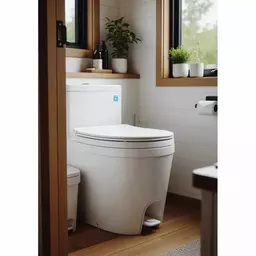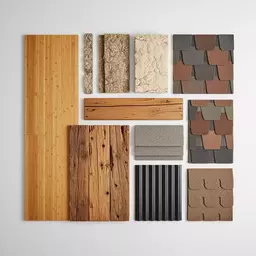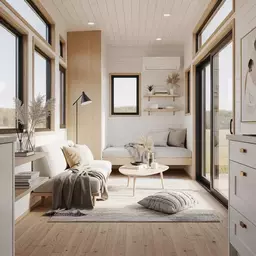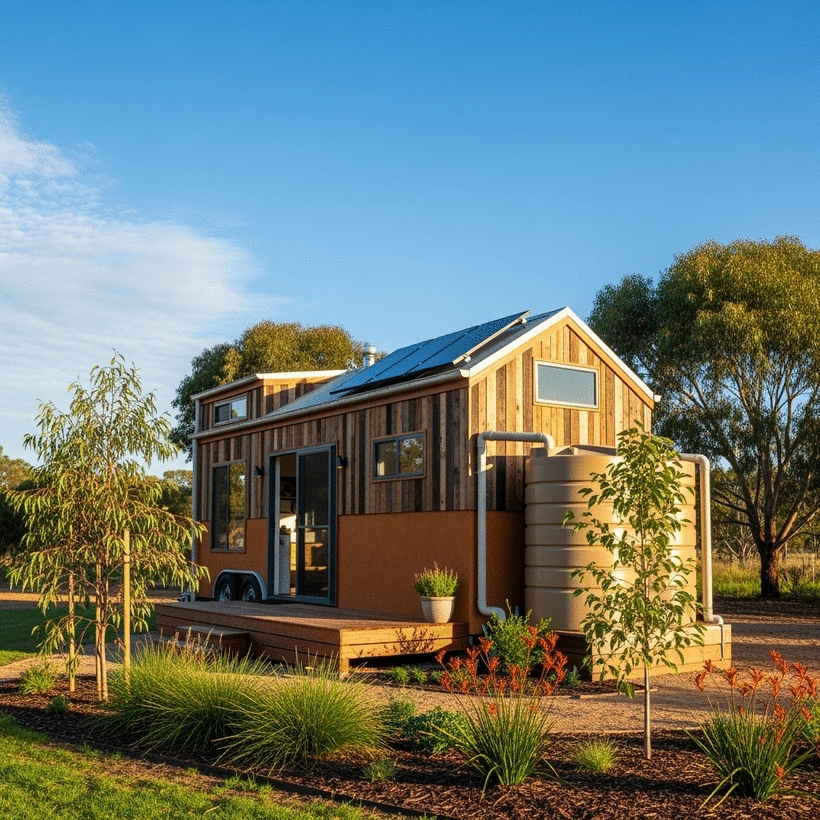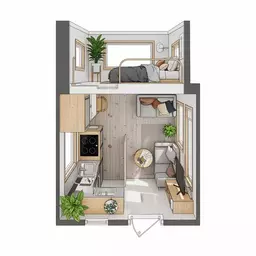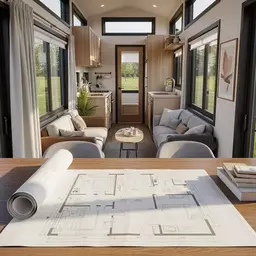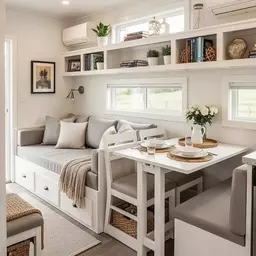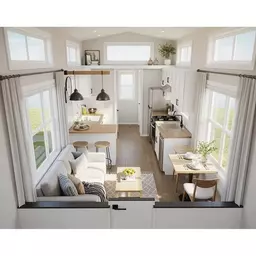Eco-Friendly Tiny Home Materials Guide
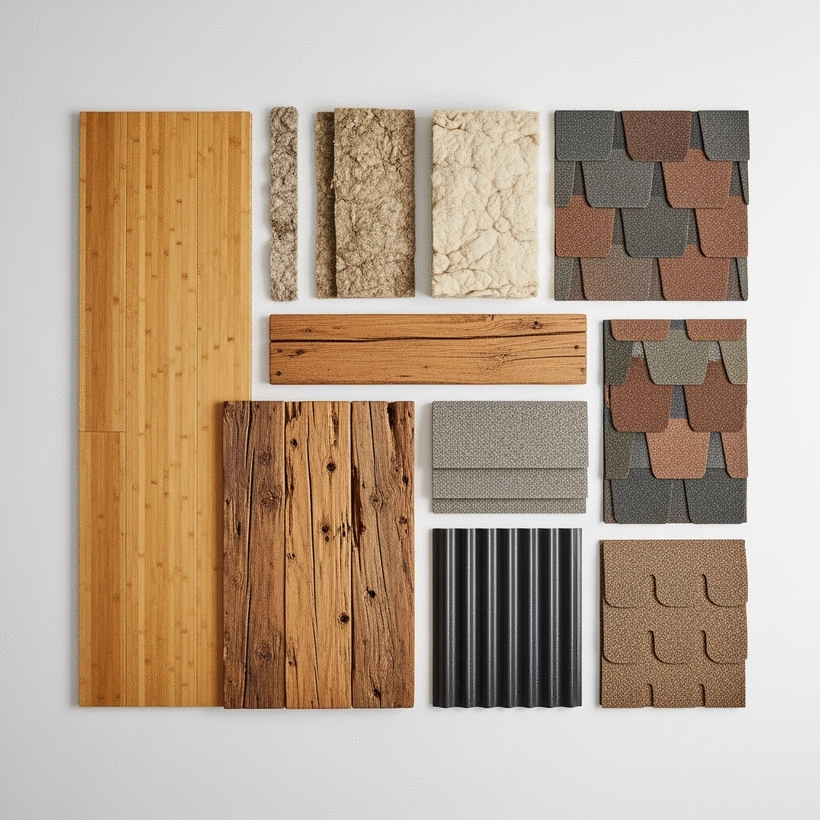
What if your next home could be both a sanctuary and a statement? Tiny homes represent a shift towards minimalism that not only addresses our living needs but also our environmental responsibilities.
What You Will Learn
- Tiny homes promote eco-friendly living by minimizing energy consumption and waste.
- The selection of sustainable materials can significantly improve the longevity and comfort of your home.
- Using local, renewable, and recyclable materials reduces environmental impact during construction.
- Choosing eco-friendly materials leads to healthier indoor environments with better air quality.
- Engaging with your community on sustainable practices can inspire collective action toward eco-friendly building.
Benefits of Eco-Friendly Materials for Tiny Homes
Making informed choices for your tiny home involves selecting sustainable materials. These choices offer several advantages, contributing to both your lifestyle and the environment. To learn more about incorporating sustainable practices, explore how sustainable materials for tiny homes can make a difference.
Improved Energy Efficiency
Many sustainable materials offer better insulation, significantly reducing your energy usage and bills.
Longer Lifespan
Eco-friendly materials often outlast traditional options, meaning fewer replacements and less waste over time.
Healthier Living Environment
Sustainable materials typically have fewer harmful chemicals, leading to better indoor air quality for residents.
Reduced Carbon Footprint
By choosing sustainable materials, you actively contribute to lowering environmental impact and preserving the planet.
Understanding Affordable and Eco-Friendly Tiny Home Materials in Australia
As an advocate for minimalism and sustainable design, I often find myself exploring the many benefits of tiny homes. Choosing tiny homes isn’t just about downsizing—it's about making a lifestyle choice that prioritizes eco-friendliness. With increasing awareness around environmental issues, more Australians are seeking ways to reduce their carbon footprints. Tiny homes represent a movement towards sustainable living, showcasing that we can enjoy comfortable living spaces while being kind to our planet.
In this journey, understanding the materials we use is crucial. Selecting the right materials for your tiny home can significantly enhance its sustainability. Affordable and eco-friendly materials not only contribute to a lower environmental impact but also ensure that your tiny home is built for longevity. Let’s dive into why material selection is vital for sustainable building practices.
Why Choose Tiny Homes: The Eco-Friendly Movement
Tiny homes are at the forefront of the eco-friendly movement, embodying the principles of minimalism and sustainability. By living in a smaller space, we naturally consume less. This shift in perspective leads to a more mindful relationship with our belongings and our environment. Embracing tiny living means prioritizing efficiency, reducing waste, and supporting local economies through sustainable practices. For innovative and space-saving ideas, check out these smart space solutions for tiny homes.
- Reduced energy consumption due to smaller living spaces
- Lower maintenance costs, leading to long-term financial savings
- Encouragement of community living and environmental stewardship
As a tiny home enthusiast, I love sharing how these homes not only provide functional spaces but also align with a sustainable lifestyle. Are you ready to embrace this eco-friendly movement?
The Importance of Material Selection for Sustainable Building
The materials used in constructing tiny homes directly impact their ecological footprint. Choosing sustainable materials can be a game changer for both the environment and your living experience. Consider this: materials that are renewable, recyclable, or made from local resources can significantly reduce the overall energy consumed during the building process. Thoughtful material selection leads to healthier indoor environments as well.
- Reduces reliance on non-renewable resources
- Minimizes construction waste and environmental impact
- Enhances the aesthetic appeal of your home while promoting sustainability
I often recommend my clients to look for materials that tell a story—those that reflect not only eco-friendliness but also creativity. The right choices can make your tiny home a true sanctuary that resonates with your values.
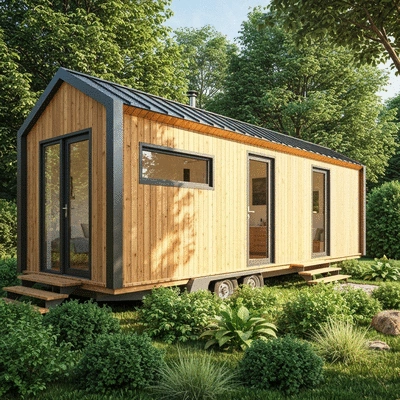
Exploring Key Eco-Friendly Materials for Tiny Homes
Once you understand the significance of material selection, the next step is exploring the best sustainable options available. There are several innovative materials that can transform your tiny home into an eco-friendly haven. From bamboo to recycled metals, the variety is vast. Let’s take a closer look at these materials and how they can enhance your tiny home experience.
Pro Tip
When selecting materials for your tiny home, consider incorporating reclaimed or upcycled materials. Not only do they reduce waste, but they also add unique character and history to your space. Think about using reclaimed wood for flooring or upcycled metal for roofing—these choices can significantly enhance both the aesthetics and sustainability of your home!
Key Takeaways: Making Informed Choices for Your Tiny Home
Building your own tiny home is an exciting journey that goes beyond just physical construction; it’s about making informed choices that align with your values. One of the most significant decisions you'll face is selecting eco-friendly materials. These sustainable options not only enhance the aesthetic appeal of your home but also contribute positively to the environment. By choosing eco-friendly materials, you can enjoy benefits such as reduced energy consumption, lower maintenance costs, and a smaller carbon footprint.
Some key benefits of eco-friendly materials include:
- Improved Energy Efficiency: Many sustainable materials offer better insulation, reducing your energy usage.
- Longer Lifespan: Eco-friendly materials often outlast traditional options, meaning fewer replacements.
- Healthier Living Environment: Sustainable materials typically have fewer harmful chemicals, leading to better indoor air quality.
As you explore your options, consider how these materials will not only shape the physical appearance of your tiny home but also reflect your commitment to a more sustainable lifestyle.
Encouraging Sustainable Building Practices in Australia
At Luxe Tiny Homes, we are passionate about advocating for sustainable building practices across Australia. Embracing eco-friendly materials isn’t just a trend—it’s a necessity for creating a better future for our planet. By choosing sustainable options, you're making a statement about the importance of caring for our environment. For more detailed insights, explore various eco-friendly materials for tiny homes.
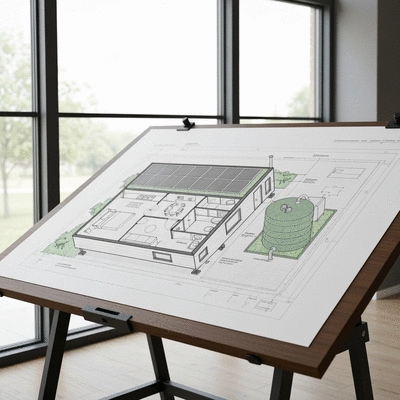
Here are some ways you can encourage sustainable building practices in your own community:
- Educate others about the benefits of using recycled and renewable materials.
- Support local suppliers who prioritize sustainability in their offerings.
- Share your own tiny home journey and inspire others to consider eco-friendly designs.
Remember, every small action contributes to a larger movement toward sustainable living. Together, we can create a community that values both innovation and environmental stewardship.
Frequently Asked Questions (FAQs)
What are the main benefits of using eco-friendly materials for tiny homes?
Eco-friendly materials offer several benefits, including improved energy efficiency, a longer lifespan for your home, a healthier indoor living environment due to fewer harmful chemicals, and a reduced carbon footprint, contributing positively to the environment.
How do tiny homes contribute to an eco-friendly lifestyle?
Tiny homes promote an eco-friendly lifestyle by encouraging minimalism, leading to reduced consumption and waste. Their smaller size naturally translates to lower energy usage, maintenance costs, and a smaller environmental footprint, aligning with sustainable living principles.
What types of sustainable materials are recommended for tiny homes?
Recommended sustainable materials include renewable, recyclable, and locally sourced options like bamboo, reclaimed wood, recycled metals, and natural insulation materials. These choices help reduce the environmental impact during construction and throughout the home's lifespan.
Why is material selection important for sustainable building?
Material selection is crucial because it directly impacts the ecological footprint of a tiny home. Choosing sustainable materials reduces reliance on non-renewable resources, minimizes construction waste, and enhances indoor air quality, leading to a healthier and more sustainable living environment.
How can I get started with choosing eco-friendly materials for my tiny home?
Begin by listing materials that align with your sustainability and aesthetic goals. Research local suppliers specializing in sustainable products, and request samples or quotes to compare options. Joining a tiny home community can also provide valuable support and resources.
Get Started on Your Tiny Home Journey Today
Take Action: Compile Your Material Options and Supplier Contacts
Now that you have a clear understanding of the benefits and options for eco-friendly materials, it’s time to take action! Start by creating a list of materials that resonate with your vision for your tiny home. Think about how each option aligns with your goals for sustainability and aesthetics.
Additionally, consider reaching out to local suppliers to gather more information about their offerings. Here’s a quick checklist to help you get started:
- Identify the eco-friendly materials that suit your design.
- Research local suppliers who specialize in sustainable products.
- Request samples or quotes to compare options.
Taking these steps will put you on the path to creating a truly unique and environmentally conscious living space!
Join the Tiny Home Community for Ongoing Support and Resources
Your tiny home journey doesn’t have to be a solo adventure! Joining a community of like-minded individuals can provide you with invaluable support and resources. At Luxe Tiny Homes, we encourage you to connect with fellow tiny home enthusiasts and builders.
Here are some ways to get involved:
- Participate in local tiny home meetups and workshops.
- Follow online forums and social media groups dedicated to tiny living.
- Share your progress, ask questions, and learn from others’ experiences.
Building a tiny home is about more than just the structure; it’s about fostering a lifestyle that values simplicity, sustainability, and community. Are you ready to take that leap? To help you visualize your future home, explore our wide range of tiny home floor plans online. Let’s embark on this journey together! 🌱
Recap of Key Points
Here is a quick recap of the important points discussed in the article:
- Embrace Minimalism: Tiny homes encourage a simpler lifestyle by reducing consumption and waste.
- Choose Sustainable Materials: Opt for renewable, recyclable, and locally sourced materials to minimize environmental impact.
- Benefits of Eco-Friendly Living: Enjoy improved energy efficiency, longer material lifespan, and a healthier living environment.
- Community Engagement: Support local suppliers and educate others about sustainable building practices.
- Take Action: Compile a list of eco-friendly materials and connect with suppliers to start your tiny home journey.
